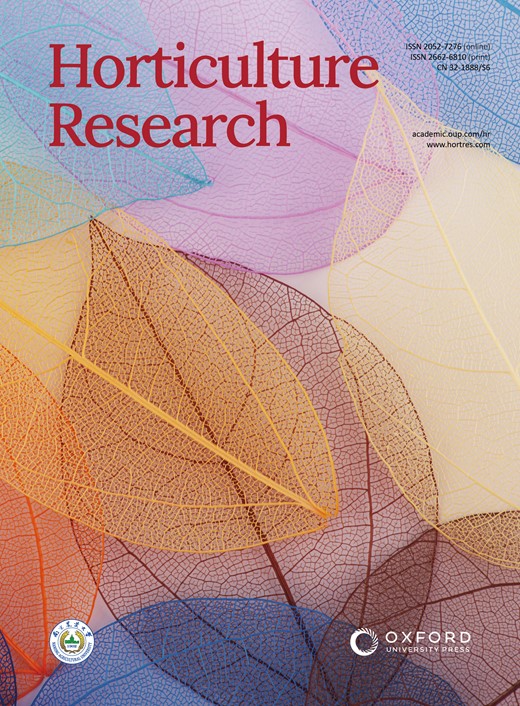黑枸杞(Lycium ruthenicum Murr.)的高质量基因组为花青素生物合成的遗传调控提供了启示
IF 8.7
1区 农林科学
Q1 Agricultural and Biological Sciences
引用次数: 0
摘要
黑枸杞(Lycium ruthenicum Murr.)此外,其果实富含花青素,具有重要的食用和药用价值。然而,目前还没有该物种染色体水平的高质量基因组,花青素生物合成的调控机制也不清楚。本研究利用单倍体材料组装了一个高质量的枸杞染色体级参考基因组,基因组大小为 2,272 Mb,等位基因 N50 为 92.64 Mb,注释基因模型为 38,993 个。此外,还确定了该基因组的进化过程以及与宁夏枸杞相比的大规模变异。重要的是,同源注释确定了参与花青素生物合成调控途径的 86 个基因,其中 5 个基因[LrCHS1(evm.TU.Chr05.295)、LrCHS2(evm.TU.Chr09.488)、LrAOMT(evm.TU.通过转录组和代谢组检测相结合的差异表达分析和相关性分析,筛选出了 LrF3'5'H (evm.TU.Chr06.177)和 LrAN2.1 (evm.TU.Chr05.2618)]。这些基因的过表达可显著上调或下调花青素相关代谢物。这些结果将有助于加速芸苔素的功能基因组研究,阐明参与花青素合成的基因将有利于培育新品种和进一步挖掘其生态保护潜力。本文章由计算机程序翻译,如有差异,请以英文原文为准。
High-quality genome of black wolfberry (Lycium ruthenicum Murr.) provides insights into the genetics of anthocyanin biosynthesis regulation
Black wolfberry (Lycium ruthenicum Murr.) is an important plant for ecological preservation. In addition, its fruits are rich in anthocyanins and have important edible and medicinal value. However, a high quality chromosome-level genome for this species is not yet available, and the regulatory mechanisms involved in the biosynthesis of anthocyanins are unclear. In this study, haploid material was used to assemble a high-quality chromosome-level reference genome of Lycium ruthenicum, resulting in a genome size of 2,272 Mb with contig N50 of 92.64 Mb, and 38,993 annotated gene models. In addition, the evolution of this genome and large-scale variations compared with the Ningxia wolfberry Lycium barbarum were determined. Importantly, homology annotation identified 86 genes involved in the regulatory pathway of anthocyanin biosynthesis, five of which [LrCHS1 (evm.TU.Chr05.295), LrCHS2 (evm.TU.Chr09.488), LrAOMT (evm.TU.Chr09.809), LrF3'5'H (evm.TU.Chr06.177) and LrAN2.1 (evm.TU.Chr05.2618)] were screened by differential expression analysis and correlation analysis using a combination of transcriptome and metabolome testing. Overexpression of these genes could significantly up- or downregulate anthocyanin-related metabolites. These results will help accelerate the functional genomic research of L. ruthenicum, and the elucidation of the genes involved in anthocyanin synthesis will be beneficial for breeding new varieties and further exploring its ecological conservation potential.
求助全文
通过发布文献求助,成功后即可免费获取论文全文。
去求助
来源期刊

Horticulture Research
Biochemistry, Genetics and Molecular Biology-Biochemistry
CiteScore
11.20
自引率
6.90%
发文量
367
审稿时长
20 weeks
期刊介绍:
Horticulture Research, an open access journal affiliated with Nanjing Agricultural University, has achieved the prestigious ranking of number one in the Horticulture category of the Journal Citation Reports ™ from Clarivate, 2022. As a leading publication in the field, the journal is dedicated to disseminating original research articles, comprehensive reviews, insightful perspectives, thought-provoking comments, and valuable correspondence articles and letters to the editor. Its scope encompasses all vital aspects of horticultural plants and disciplines, such as biotechnology, breeding, cellular and molecular biology, evolution, genetics, inter-species interactions, physiology, and the origination and domestication of crops.
 求助内容:
求助内容: 应助结果提醒方式:
应助结果提醒方式:


